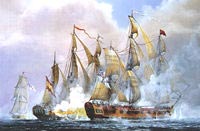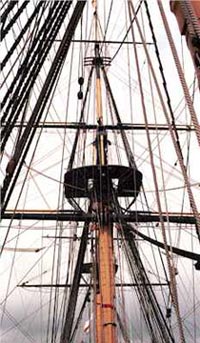| (insert your NIE or newspaper logo here) |
Weekly Online LessonOnline Lesson ArchiveGrade Level: 6-11
|
Mastering the Sea
 On
Thursday, November 14, 2003, the movie Master and Commander: The
Far Side of the World opened in cinemas nationwide.
On
Thursday, November 14, 2003, the movie Master and Commander: The
Far Side of the World opened in cinemas nationwide.
Much has been talked about in terms of the actors, the special effects, the filming of it and the novels upon which it's based. Less has been said about the time period during which the movie's events occur — the era of the Napoleonic Wars in the early 1800s.
Following the French Revolution, Napoleon I of France launched a series of European wars with the aim of controlling Europe. This included an attempt to invade Britain. Napoleon's army won the land, but Britain had established a strong trading empire and essentially ruled the seas with its well-funded Royal Navy. The British ships put a stop to the invasion, and Napoleon was forced to limit his most strategic movements to terra firma.
For this week's lesson, you'll explore the world through the eyes of a British ship's crew. You'll discover what living and working on the high seas was like during the early 19th century, sailing on both a warship and a vessel of exploration.
Pursuing the Foe
 Begin
by joining up with the Royal Navy's Capt. Jack Aubrey to Follow
the Voyage of the Surprise at the Master and Commander
movie's website. (Flash Player required.)
Begin
by joining up with the Royal Navy's Capt. Jack Aubrey to Follow
the Voyage of the Surprise at the Master and Commander
movie's website. (Flash Player required.)
At various points along the route, you'll read an entry from the Captain's Log, then click Continue to learn more about the ship. Click Continue the Journey to move on to the next point. Occasionally along the way, the Continue screens will supply a video clip of the movie related to the featured point. The sound can be turned on or off using the on-screen speaker control at the bottom left.
Start by clicking on the top right yellow and orange square at the beginning of the route. After reading the Captain's Log, click Continue to find out more about Captain Aubrey and his responsibility to his ship and crew. You'll also listen to the Captain's speech to his men as they begin their journey to the "Far Side of the World."
 As
you sail southward toward the tip of South America, you'll learn about
the ship's many Sails, gain some Nautical Knowledge,
and meet the French ship, The Acheron.
As
you sail southward toward the tip of South America, you'll learn about
the ship's many Sails, gain some Nautical Knowledge,
and meet the French ship, The Acheron.
How do the multiple sails work together to harness the wind power under any given conditions? What nautical terms are familiar in our modern speech? How did the military forces and ships of the French compare to those of the British?
Continue the journey and meet the ship's Officers, get a taste of Life On A Tall Ship from the stomach's viewpoint, and then meet the rest of the Crew and the Warrants Officers.
How does each person's job and rank help ensure the survival of the ship as a whole? In what ways could their typical diet affect each crewman's overall health?
Move through the rest of the journey until you reach the Galapagos. If you'd like to revisit any of the previous points, hop up into the Crow's Nest at the top right of the screen.
What would you say was the most challenging aspect of being a crewman on the H.M.S. Surprise? What was the most rewarding? How did the experiences of such ships help the crew and others to understand the Earth's ocean and wind currents, like those around Cape Horn? How was maritime combat different from and similar to that on land? How does it compare to modern warfare?
Exploring New Horizons
 Your
next assignment is with The
Navigators, where you'll explore Terra Australis Incognita
on the other side of the South Pacific Ocean.
Your
next assignment is with The
Navigators, where you'll explore Terra Australis Incognita
on the other side of the South Pacific Ocean.
Start with the History section, and find out why this era promoted the advancement of science.
Move down the main navigation bar to meet the Captains and the Naturalists.
In what ways were the captains and the naturalists important assets to Britain?
Next, check out the Ships section, and take the Interactive Tour of the ship, Investigator, where you'll learn even more about the components of these amazing wooden ships. You can also read about Investigator's Life, and the History of Sailing Ships.
Along with a ship, a captain also needs someone who knows The Art of Navigation, called the Navigator. How did advancements in technology and scientific understanding improve navigational abilities? In what ways did Maps change, thanks to better and broader understanding of the Earth and the stars?
Newspaper Activities
Browse issues of Targetnewspaper to find stories about historic or modern battles, especially those fought on or in the water. How does the way people did battle in the 19th century compare? How do the vessels, vehicles or other type of equipment used influence warfare tactics? How well have people fighting on each side of the battle mastered the terrain upon which they're fighting? In what ways does it matter? Does the scientific or strategic knowledge gained by the battle contribute to civilian life in some way?
© Copyright 2003
Learners Online, Inc.
